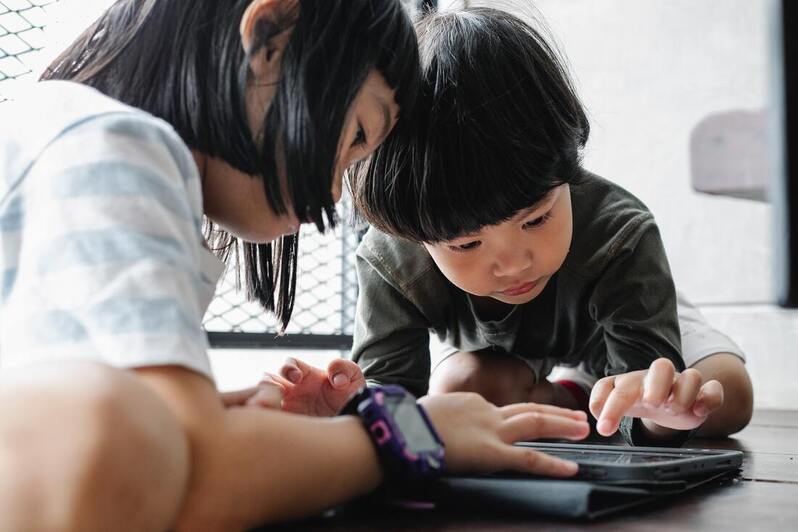Effect of Screen Use on Children's Mental Health during COVID-19
During the Covid-19 pandemic, children had more time on their devices than ever. Lack of human interaction and increased use of technology could have lasting impacts on those who missed key developmental milestones during quarantine. Although the lingering effects of the pandemic cannot be fully explored, this time of extreme isolation allowed for important research on the effects of increased digital media consumption on the mental health of small children and adolescents.
One Canadian study conducted from 2020 to 2021 might have uncovered some of the impacts of this higher usage. Collecting data from the parents of 532 children ages 6-18, scientists in Ontario confirmed that, on average, children exceeded their recommended one-to-two hours of screen time per day to alarming results. Parents were asked to fill out a strengths-and-difficulties questionnaire about their children every month for 11 months, with these results being validated with the nine criteria for depression on the Revised Children’s Anxiety and Depression Scale (RCADS) and the ten criteria for anxiety in the Screen for Child Anxiety Related Disorders (SCARED) every month. The Irritability and Dysregulation of Emotions questionnaire (TIDES) was also administered three times and the Strengths and Weaknesses of Attention-Deficit/Hyperactivity Disorder Symptoms and Normal Behavior Scale (SWAN) was used to measure was used to measure hyperactivity and inattention twice.
One Canadian study conducted from 2020 to 2021 might have uncovered some of the impacts of this higher usage. Collecting data from the parents of 532 children ages 6-18, scientists in Ontario confirmed that, on average, children exceeded their recommended one-to-two hours of screen time per day to alarming results. Parents were asked to fill out a strengths-and-difficulties questionnaire about their children every month for 11 months, with these results being validated with the nine criteria for depression on the Revised Children’s Anxiety and Depression Scale (RCADS) and the ten criteria for anxiety in the Screen for Child Anxiety Related Disorders (SCARED) every month. The Irritability and Dysregulation of Emotions questionnaire (TIDES) was also administered three times and the Strengths and Weaknesses of Attention-Deficit/Hyperactivity Disorder Symptoms and Normal Behavior Scale (SWAN) was used to measure was used to measure hyperactivity and inattention twice.
Image Source: cottonbro studio
Higher television or digital media consumption (YouTub and social media, for example.) was associated with hyperactivity and attention issues as well as symptoms of depression and anxiety. Children in online learning also showed worse mental health than those who attended in-person schools. More hours spent playing video games was also correlated with depression, anxiety, attention issues, and conduct problems.
While these results may be expected, there were several interesting findings of how such extreme isolation and reliance on technology for social interaction impacted children. Notably, children on the autism spectrum did not experience increased symptoms of depression during the pandemic. The researchers speculate that this is due to less demanding social interactions and pre-existing access to therapy. Facetime and other video chatting was also not shown to improve children’s mental health. Other studies (here and here) also confirmed that video chatting was associated with heightened depression and anxiety.
Overall, the Covid-19 pandemic provided valuable information about the effects of technology on children as society becomes more reliant on it for educational and social purposes. Usage should be limited and not treated as a substitute for in-person interaction as online interaction is not shown to alleviate the negative effects of isolation. Television and media consumption showed the greatest impact on mental health, so they should be more heavily regulated. This information can better inform parents and educators to support children’s mental health in the future.
While these results may be expected, there were several interesting findings of how such extreme isolation and reliance on technology for social interaction impacted children. Notably, children on the autism spectrum did not experience increased symptoms of depression during the pandemic. The researchers speculate that this is due to less demanding social interactions and pre-existing access to therapy. Facetime and other video chatting was also not shown to improve children’s mental health. Other studies (here and here) also confirmed that video chatting was associated with heightened depression and anxiety.
Overall, the Covid-19 pandemic provided valuable information about the effects of technology on children as society becomes more reliant on it for educational and social purposes. Usage should be limited and not treated as a substitute for in-person interaction as online interaction is not shown to alleviate the negative effects of isolation. Television and media consumption showed the greatest impact on mental health, so they should be more heavily regulated. This information can better inform parents and educators to support children’s mental health in the future.
Featured Image Source: Alex Green
RELATED ARTICLES
|
Vertical Divider
|
Vertical Divider
|
Vertical Divider
|






